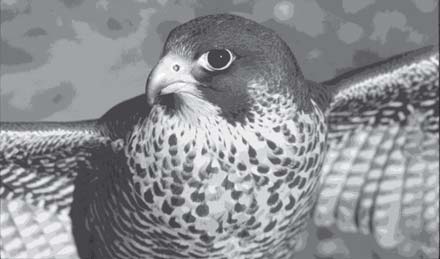The Peregrine Returns By Kate Davis
Recovery of endangered falcon an unqualified success
Peregrine Falcons deserve to be one of the most celebrated animals on the planet. They are undeniably the fastest, clocking speeds of more than 200 miles an hour in vertical “stoops” or dives in pursuit of prey. Along with the Osprey, Peregrines are cosmopolitan, or a species with worldwide distribution. And, they are the first bird to be removed from the United States Department of the Interior’s Endangered Species List – one of the greatest recovery stories ever.

The reason the Peregrine made it on the list in the first place is a result of human activities. The use of pesticides such as DDT after World War II caused reproductive failure and was a death knell for many kinds of predatory birds at the top of the food chain. By the 1970s, not a single Peregrine nest could be found in Montana and they were extinct east of the Great Plains. But the story of Peregrine recovery is also due to human intervention, specifically by thousands of participants in the U.S. and Canada who ensured a happy ending for this engaging falcon
In 1965 the alarm was sounded that Peregrine numbers in the U.S and Britain had declined drastically. Biologists and falconers decided that quick action was necessary and the Peregrine Fund was formed with the purpose of trying to restore this bird to pre-DDT numbers. In Montana, as across the country, captive-bred Peregrines were released to the wild from “hacking” stations. The Rocky Mountain Peregrine subspecies is called Falco peregrinus anatum, and these were the only race of bird to be raised for reintroduction in the western U.S. and Canada. (The eastern U.S. birds were bred from 5 subspecies in a mixture available from the budding breeding program encouraged by this urgency for species survival.)
The intention was to take young chicks at the age of 37-38 days from breeders and place them in plywood containers with a full view of their future surrounding hunting grounds, usually on natural cliffs or on specially constructed towers.. Hack site attendants fed the chicks whole quail dropped into a feeding tube so the birds wouldn’t associate with humans. At 45 days of age, the now flighted falcons were released by opening up the front of the hack box. The youngsters usually remained around their artificial nest for four or five weeks after fledging and continued being fed by their attendants until the birds became skilled at hunting on their own.
Peregrines become old enough to breed between 2 and 4 years of age, and a significant number of hacked birds returned to their former sites or found new ones. More than 6,000 peregrines were released in North America over 30 years, mostly out of hack boxes. Now in the Midwestern U.S., 70 percent of nests are urban, located on buildings, bridges and smokestacks away from the deadliest of their predators, Great Horned Owls. Fifteen pairs may be seen snatching pigeons above the streets of New York City. The world has changed and these new Peregrines have learned to adapt.
Closer to home, 28 hack sites were used in Montana, the first at Red Rocks National Wildlife Refuge in 1981. By 1998, the last year of this program, 617 birds had been released statewide. Curiously, no historic Peregrine nests had been recorded in the Bitterroot Valley despite the optimal hunting and breeding conditions. Here were steep canyon cliffs near water with a wide valley for foraging – a perfect-seeming habitat. The first Bitterroot hack site was at Painted Rocks Reservoir in 1991, and birds soon occupied there, followed by Canyon Creek and Blodgett Canyon. Now the Bitterroot Valley is occupied by a record number of breeding pairs, with 9 active eyries, or nests, in 2004.
The nature of Peregrine Falcons, as with most raptors, is to return to their natal origins to breed, so we are ensured a healthy population of Peregrines in the Bitterroot and along many waterways in Montana for the future. The crowning achievement of these recovery efforts was the Peregrine’s de-listing, or removal from the Endangered Species List on August 20, 1999.
We can thank members of the Peregrine Fund for their insight, private sources for funding and agency support from the Fish and Wildlife Service, Forest Service, BLM and many others. Plus kudos to Jay Sumner and Ralph Rogers of the Montana Peregrine Institute for their ongoing monitoring of the status of this species. We had 40 active Montana eyries in 2003, and this year Jay and Ralph found 10 new nests in the state, all on the Clark Fork and Flathead Rivers.
Young falcons fledge around the 10th of July, and this is the best time for viewing as they learn flight skills and noisily harass their parents. Observations are best from below and at some distance from the nest; never from above the eyrie, especially if young are still in the nest. Last year, two young falcons fledged to the wonder and delight of observers sitting across the river in lawn chairs and on tailgates in a state park. A warning though: Falcon watching can be addictive. If you are lucky, you will see a wild Peregrine and immediately know why this bird deserved its triumph after a brush with extinction. They are simply the pinnacle of perfection.
Article courtesy of the Montana Naturalist Magazine, fall 2004 issue. Published by the Montana NaturalHistory Center. Call (406) 327-0405 for a copy